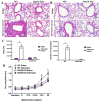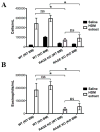Pulmonary receptor for advanced glycation end-products promotes asthma pathogenesis through IL-33 and accumulation of group 2 innate lymphoid cells
- PMID: 25930197
- PMCID: PMC4562894
- DOI: 10.1016/j.jaci.2015.03.011
Pulmonary receptor for advanced glycation end-products promotes asthma pathogenesis through IL-33 and accumulation of group 2 innate lymphoid cells
Abstract
Background: Single nucleotide polymorphisms in the human gene for the receptor for advanced glycation end-products (RAGE) are associated with an increased incidence of asthma. RAGE is highly expressed in the lung and has been reported to play a vital role in the pathogenesis of murine models of asthma/allergic airway inflammation (AAI) by promoting expression of the type 2 cytokines IL-5 and IL-13. IL-5 and IL-13 are prominently secreted by group 2 innate lymphoid cells (ILC2s), which are stimulated by the proallergic cytokine IL-33.
Objective: We sought to test the hypothesis that pulmonary RAGE is necessary for allergen-induced ILC2 accumulation in the lung.
Methods: AAI was induced in wild-type and RAGE knockout mice by using IL-33, house dust mite extract, or Alternaria alternata extract. RAGE's lung-specific role in type 2 responses was explored with bone marrow chimeras and induction of gastrointestinal type 2 immune responses.
Results: RAGE was found to drive AAI by promoting IL-33 expression in response to allergen and by coordinating the inflammatory response downstream of IL-33. Absence of RAGE impedes pulmonary accumulation of ILC2s in models of AAI. Bone marrow chimera studies suggest that pulmonary parenchymal, but not hematopoietic, RAGE has a central role in promoting AAI. In contrast to the lung, the absence of RAGE does not affect IL-33-induced ILC2 influx in the spleen, type 2 cytokine production in the peritoneum, or mucus hypersecretion in the gastrointestinal tract.
Conclusions: For the first time, this study demonstrates that a parenchymal factor, RAGE, mediates lung-specific accumulation of ILC2s.
Keywords: Asthma; IL-33; group 2 innate lymphoid cells; receptor for advanced glycation end-products.
Copyright © 2015 American Academy of Allergy, Asthma & Immunology. Published by Elsevier Inc. All rights reserved.
Conflict of interest statement
Figures







References
-
- Barlow JL, Peel S, Fox J, Panova V, Hardman CS, Camelo A, et al. IL-33 is more potent than IL-25 in provoking IL-13-producing nuocytes (type 2 innate lymphoid cells) and airway contraction. J Allergy Clin Immunol. 2013 Oct;132(4):933–41. Epub 2013/07/03. eng. - PubMed
-
- Chu DK, Llop-Guevara A, Walker TD, Flader K, Goncharova S, Boudreau JE, et al. IL-33, but not thymic stromal lymphopoietin or IL-25, is central to mite and peanut allergic sensitization. J Allergy Clin Immunol. 2013 Jan;131(1):187–200. e1–8. Epub 2012/09/26. eng. - PubMed
-
- Schmitz J, Owyang A, Oldham E, Song Y, Murphy E, McClanahan TK, et al. IL-33, an interleukin-1-like cytokine that signals via the IL-1 receptor-related protein ST2 and induces T helper type 2-associated cytokines. Immunity. 2005 Nov;23(5):479–90. Epub 2005/11/16. eng. - PubMed
Publication types
MeSH terms
Substances
Grants and funding
- 5T32HL094295-03/HL/NHLBI NIH HHS/United States
- 1T32HL094295/HL/NHLBI NIH HHS/United States
- AI048927/AI/NIAID NIH HHS/United States
- R01 HL113956/HL/NHLBI NIH HHS/United States
- 1T32HL094295-01A2/HL/NHLBI NIH HHS/United States
- R01 AI048927/AI/NIAID NIH HHS/United States
- R21 HL095495/HL/NHLBI NIH HHS/United States
- 5T32HL094295-04/HL/NHLBI NIH HHS/United States
- UL1 TR000005/TR/NCATS NIH HHS/United States
- F30 ES024045/ES/NIEHS NIH HHS/United States
- 5R21HL095495-02/HL/NHLBI NIH HHS/United States
- 5T32HL094295/HL/NHLBI NIH HHS/United States
- HL113956/HL/NHLBI NIH HHS/United States
- 1F30ES024045-01/ES/NIEHS NIH HHS/United States
- T32 HL094295/HL/NHLBI NIH HHS/United States
LinkOut - more resources
Full Text Sources
Other Literature Sources
Medical

